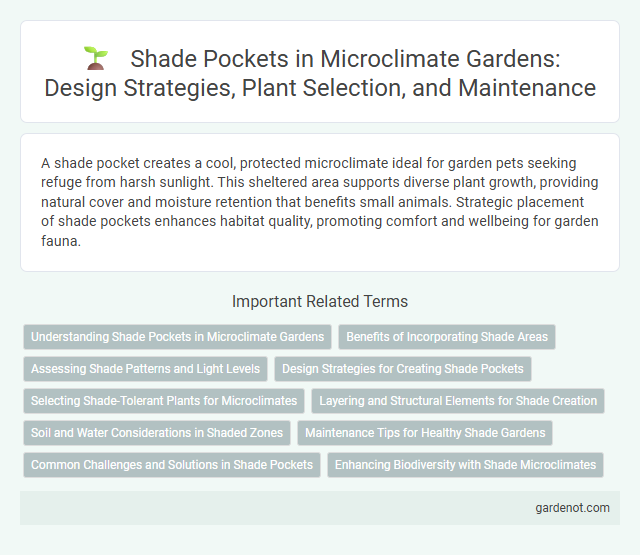A shade pocket creates a cool, protected microclimate ideal for garden pets seeking refuge from harsh sunlight. This sheltered area supports diverse plant growth, providing natural cover and moisture retention that benefits small animals. Strategic placement of shade pockets enhances habitat quality, promoting comfort and wellbeing for garden fauna.
Understanding Shade Pockets in Microclimate Gardens
Shade pockets in microclimate gardens create localized areas with reduced sunlight due to natural or structural obstructions, significantly influencing plant growth and biodiversity. These pockets maintain cooler temperatures and higher humidity, fostering microhabitats ideal for shade-tolerant species such as ferns, hostas, and mosses. Understanding the formation and dynamics of shade pockets enables gardeners to strategically select and position plants, enhancing garden resilience and ecological balance.
Benefits of Incorporating Shade Areas
Shade pockets in microclimate gardens reduce heat stress by lowering temperatures and limiting direct sunlight exposure, which supports plant health and conserves soil moisture. These shaded areas create cooler microhabitats that attract beneficial insects and wildlife, promoting biodiversity in the garden ecosystem. Incorporating shade pockets enhances overall comfort for gardeners and extends the growing season for shade-tolerant plants.
Assessing Shade Patterns and Light Levels
A shade pocket in a microclimate garden is identified by carefully assessing shade patterns and measuring light levels throughout the day using a light meter or smartphone app. Understanding the intensity and duration of sunlight helps determine suitable plant species that thrive in low-light conditions, optimizing growth and health. Accurate evaluation of these factors ensures the microclimate supports a sustainable, aesthetic garden environment.
Design Strategies for Creating Shade Pockets
Design strategies for creating shade pockets in microclimate gardens include positioning dense foliage trees or tall shrubs to block direct sunlight while maintaining airflow. Incorporating layered vegetation, such as understory plants beneath canopy species, enhances cooling through evapotranspiration and provides refuge for shade-loving plants. Utilizing hardscape elements like pergolas or trellises with climbing vines further modulates sunlight exposure, reducing heat accumulation in targeted garden areas.
Selecting Shade-Tolerant Plants for Microclimates
Choosing shade-tolerant plants such as ferns, hostas, and astilbe thrives in microclimate garden shade pockets by adapting to low light and higher humidity. These plants require well-draining soil enriched with organic matter to support healthy growth in shaded areas. Incorporating native shade species enhances biodiversity and ensures sustainability within the microclimate garden environment.
Layering and Structural Elements for Shade Creation
Shade pockets in microclimate gardens are created through strategic layering of plants and structural elements, maximizing cooling effects and protection from direct sunlight. Incorporating tall trees, dense shrubs, and climbing vines along with pergolas or trellises enhances vertical and horizontal shade, fostering diverse microhabitats. These layered shade zones improve soil moisture retention and reduce temperature fluctuations, promoting healthier plant growth and sustainable garden ecosystems.
Soil and Water Considerations in Shaded Zones
Shade pockets in microclimate gardens require carefully managed soil and water conditions to support healthy plant growth. Soils in these shaded zones tend to retain more moisture and have slower evaporation rates, necessitating well-draining organic matter to prevent waterlogging and root rot. Selecting moisture-tolerant plants and regularly monitoring soil moisture levels ensures optimal hydration and nutrient uptake in low-light environments.
Maintenance Tips for Healthy Shade Gardens
Regular pruning and removal of dead or diseased foliage help maintain airflow and reduce pest infestations in shade pocket gardens. Applying a layer of organic mulch conserves moisture and enriches soil nutrients, supporting shade-tolerant plants like ferns and hostas. Consistent monitoring for fungal diseases and adjusting watering practices prevent root rot and maintain healthy growth in shaded microclimates.
Common Challenges and Solutions in Shade Pockets
Shade pockets in microclimate gardens often face common challenges such as limited sunlight, poor air circulation, and moisture retention issues that can hinder plant growth. Selecting shade-tolerant plants like ferns, hostas, and astilbes helps overcome low light conditions, while improving soil drainage and pruning nearby vegetation enhances airflow and prevents fungal diseases. Implementing mulching techniques and using permeable materials also addresses moisture imbalance, promoting a healthier microenvironment within shade pockets.
Enhancing Biodiversity with Shade Microclimates
Shade pockets in microclimate gardens create unique habitats that support diverse plant species by providing cooler, moist conditions essential for shade-loving flora. This microenvironment encourages the presence of beneficial insects, amphibians, and birds, boosting overall biodiversity. Integrating shade pockets strategically enhances ecological resilience and promotes a balanced garden ecosystem.
Shade pocket Infographic

 gardenot.com
gardenot.com